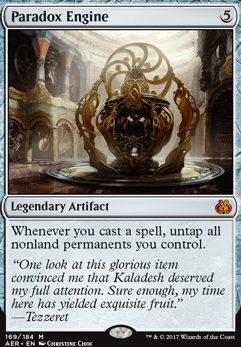
To Harness Antiquity [cEDH Primer, Rule 0]
Commander: Rule 0 Artifact Combo Competitive Infinite Combo Primer
Land (35)
- 1x Academy Ruins
- 1x Ancient Den
- 1x Badlands
-
1x
Blood Crypt

- 1x Cascade Bluffs
- 1x City of Brass
- 1x Command Tower
- 1x Fetid Heath
- 1x Fiery Islet
-
1x
Godless Shrine

- 1x Graven Cairns
- 1x Great Furnace
-
1x
Hallowed Fountain

- 1x Inventors' Fair
- 1x Library of Alexandria
- 1x Mana Confluence
- 1x Maze of Ith
- 1x Mystic Gate
- 1x Plateau
- 1x Rugged Prairie
-
1x
Sacred Foundry

- 1x Scrubland
- 1x Seat of the Synod
- 1x Silent Clearing
- 1x Spire of Industry
-
1x
Steam Vents

- 1x Sunbaked Canyon
- 1x Sunken Ruins
- 1x Tundra
- 1x Underground Sea
- 1x Urza's Saga
- 1x Vault of Whispers
- 1x Vesuva
- 1x Volcanic Island
-
1x
Watery Grave

Creature (2)
Planeswalker (1)
Artifact (30)
- 1x Aetherflux Reservoir
- 1x Arcane Signet
- 1x Black Lotus
- 1x Bloodtallow Candle
- 1x Bolas's Citadel
- 1x Codex Shredder
- 1x Ensnaring Bridge
- 1x Isochron Scepter
- 1x Lotus Petal
- 1x Mana Crypt
- 1x Mana Vault
- 1x Mox Amber
- 1x Mox Diamond
- 1x Mox Jet
- 1x Mox Pearl
- 1x Mox Ruby
- 1x Mox Sapphire
- 1x Paradox Engine
- 1x Pyrite Spellbomb
- 1x Sensei's Divining Top
- 1x Sol Ring
- 1x Static Orb
- 1x Time Vault
- 1x Tormod's Crypt
- 1x Universal Solvent
- 1x Urza's Bauble
- 1x Voltaic Key
- 1x Welding Jar
- 1x Winter Orb
- 1x Wishclaw Talisman
Sorcery (10)
Commanders (2)
Instant (20)
- 1x Ancestral Recall
- 1x Artifact Blast
- 1x Counterspell
- 1x Deflecting Swat
- 1x Dramatic Reversal
- 1x Fierce Guardianship
- 1x Force of Negation
- 1x Force of Will
- 1x Lightning Bolt
- 1x Mana Drain
- 1x Mental Misstep
- 1x Mystical Tutor
- 1x Pact of Negation
- 1x Path to Exile
- 1x Pongify
- 1x Rebuff the Wicked
- 1x Silence
- 1x Swan Song
- 1x Vampiric Tutor
Suggestions
Updates Add
Comments
Attention! Complete Comment Tutorial! This annoying message will go away once you do!
Important! Formatting tips — Comment Tutorial — markdown syntax
Please login to comment
Casual
91% Competitive
| Date added | 3 years |
| Last updated | 3 years |
| Key combos | |
| Legality | This deck is Commander: Rule 0 legal. |
| Rarity (main - side) | 11 - 0 Mythic Rares 60 - 0 Rares 17 - 0 Uncommons 12 - 0 Commons |
| Cards | 100 |
| Avg. CMC | 1.88 |
| Tokens | Ape 3/3 G, Bird 2/2 U, Construct 0/0 C, Thopter 1/1 U |
| Votes | |
| Ignored suggestions | |
| Shared with | |
| Views |


